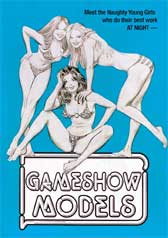 GAME
SHOW MODELS (1977)
GAME
SHOW MODELS (1977)Director: David Gottlieb
Vinegar Syndrome
 GAME
SHOW MODELS (1977)
GAME
SHOW MODELS (1977)Ever wondered by Independent-International’s GAME SHOW MODELS had so few models and not much of a game show? Check out Vinegar Syndrome’s two-disc special edition DVD set of the film which includes bonus of the film’s substantially different original cut.

Feeling unfulfilled in his escapist existence as a writer of pornographic novels and reaching the end of his “five year plan” to make something of himself in Hollywood, idealistic Stuart Guber (John Vickery) decides to embark on a to “go mainstream” by walking out on his hippie dancer girlfriend Josey (screenwriter Diane Thomas), getting a respectable haircut (well, for the seventies), and taking a trainee position at the public relations firm of megalomaniacal Roger Feinstein (Gilbert DeRush) through a connection with press liaison Marvin Schmitt (Sid Melton, TV’s MAKE ROOM FOR DADDY). He finds some succor from the monotony of his work in an affair with the “protected” younger sister CiCi (Diane Sommerfield, THE BLACK GODFATHER) of black singer Dana Sheridan (singer Thelma Houston) as well as a friendship with co-worker Arnold (Nick Pellegrino, THE ENFORCER) who has already had to lie about his age (among other things) to keep his precarious position with the company. He becomes witness to the ugly side of show business with Roger’s scheme to garner some publicity for a game show – hosted by sleazy Joe Tanner (Dick Miller, BUCKET OF BLOOD) – by “auditioning” beautiful game show models at a private press party, and pines for more innocent times with Josey who has moved on with pianist Joel (Mike McNeilly) with whom she does street performances.
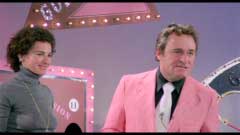 If
you’re wondering why the focus of GAME SHOW MODELS is more on Stuart (and
Arnold) than the game show or the models, it’s because it was originally
produced as THE SEVENTH DWARF (the title deriving from a question posed to Stuart
by CiCi after Roger introduces him as head of research and development), a fictionalized,
somewhat fanciful semi-autobiographical account of director David Gottlieb’s
summer working for publicist Jay Bernstein. The film was then picked up by Sam
Sherman’s Independent-International, and was one of the few extensive
recut jobs for the company not supervised by Al Adamson (or at least not originating
from an Al Adamson film); in fact, Gottlieb reveals on the commentary track
that Sherman came up with the game show models idea and ad campaign but left
it to Gottlieb to do the reshoots (during the game show sequence, co-star Melton's
name is the answer to one of the trivia questions). Scenes with a modicum of
exploitative content were retained and additional sex scenes were shot (including
the new pre-credits bit between Roger and “Chick” [Rae Sperling,
HOLLYWOOD HIGH], an explicit encounter between Stuart and CiCi, and the game
show model finale). Dick Miller’s character was also added to the film
in the game show scene in which Chick blows her lines in front of a studio audience
(before this Miller plays the scene with marvelously veiled contempt for her).
If
you’re wondering why the focus of GAME SHOW MODELS is more on Stuart (and
Arnold) than the game show or the models, it’s because it was originally
produced as THE SEVENTH DWARF (the title deriving from a question posed to Stuart
by CiCi after Roger introduces him as head of research and development), a fictionalized,
somewhat fanciful semi-autobiographical account of director David Gottlieb’s
summer working for publicist Jay Bernstein. The film was then picked up by Sam
Sherman’s Independent-International, and was one of the few extensive
recut jobs for the company not supervised by Al Adamson (or at least not originating
from an Al Adamson film); in fact, Gottlieb reveals on the commentary track
that Sherman came up with the game show models idea and ad campaign but left
it to Gottlieb to do the reshoots (during the game show sequence, co-star Melton's
name is the answer to one of the trivia questions). Scenes with a modicum of
exploitative content were retained and additional sex scenes were shot (including
the new pre-credits bit between Roger and “Chick” [Rae Sperling,
HOLLYWOOD HIGH], an explicit encounter between Stuart and CiCi, and the game
show model finale). Dick Miller’s character was also added to the film
in the game show scene in which Chick blows her lines in front of a studio audience
(before this Miller plays the scene with marvelously veiled contempt for her).
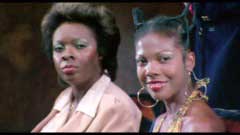
Fortunately, Vinegar Syndrome’s 2-disc set includes the original cut on a second disc. Both versions run just under 89 minutes but the footage differences are significant. This version opens on a more austere note with Stuart’s narration (the sequence which occurs after the sex scene with Roger and Chick in the release version) designating him right away as the main character (the introduction of Chick in the first scene and Josey in the second suggests to the viewer unfamiliar with the film that the film will be about their adventures as game show models after having been abandoned by their men). The first significant addition is an extended scene in which he explains Stuart’s duties (which also reveals Stuart’s interest in writing and Arnold confiding that he lied about his age). This scene precedes the sequence of Arnold showing Stuart around the office and introducing the other executives. The first meeting scene does have Roger revealing his scam to garner publicity for the show, so we can see where the idea for the reshoot took off. There are no game show scenes in the original cut, but the scene of Stuart collecting information from the models lined up in the office is present. The scene between CiCi and Stuart in her hideaway is significantly longer – they sing “The Locomotion” together and he tells her about his “five year plan” and writing pornography – but cuts away with their kiss (where the sex scene starts in the release version).
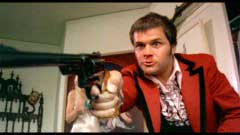 When
Stuart sees Josey in the streets in the release version, he asks her to lunch
and she assents; but the scene ends with him asking her if she’s happy
with what she’s doing before they part ways. The original version has
the two go to lunch at a diner and a roughly eight-minute extended flashback
of what she did after he left her (including her relationship with a Marxist
[Michael Knight], a nervous breakdown after taking a factory job as part of
her class consciousness, before meeting Joel). Not only does the scene make
her seem less flighty than she does with her reduced running time in the release
version, it also provides some more screen time for the late Thomas. The last
extension is more of Stuart’s aimless wandering before the optimistic
final scene. The use of Harriet Schock’s moving and thematically appropriate
song “Hollywood Town” originated with the original cut of the film
and was wisely retained. The end credits of the release version are largely
the same text and background montage, but two of the cards have been redone:
the first to remove Knight’s name and add the credits for Miller and the
game show contestant, and the second because the background shot features Knight’s
character who does not show up in the release version at all.
When
Stuart sees Josey in the streets in the release version, he asks her to lunch
and she assents; but the scene ends with him asking her if she’s happy
with what she’s doing before they part ways. The original version has
the two go to lunch at a diner and a roughly eight-minute extended flashback
of what she did after he left her (including her relationship with a Marxist
[Michael Knight], a nervous breakdown after taking a factory job as part of
her class consciousness, before meeting Joel). Not only does the scene make
her seem less flighty than she does with her reduced running time in the release
version, it also provides some more screen time for the late Thomas. The last
extension is more of Stuart’s aimless wandering before the optimistic
final scene. The use of Harriet Schock’s moving and thematically appropriate
song “Hollywood Town” originated with the original cut of the film
and was wisely retained. The end credits of the release version are largely
the same text and background montage, but two of the cards have been redone:
the first to remove Knight’s name and add the credits for Miller and the
game show contestant, and the second because the background shot features Knight’s
character who does not show up in the release version at all.
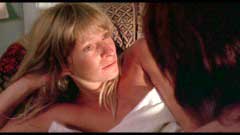
The big differences in footage do not actually change the film all that much. If you’ve seen THE SEVENTH DWARF first then the reshot additions are obvious and jarring; however, if you’ve watched GAME SHOW MODELS first, then the game show angle and the nudity that comes with it just seems a more crass visualization of the exploitation perpetrated by the characters in the film. The changes to the release version do not contradict anything that Stuart comes to realize in his end dialogue with Josey. Since the subplot relationship between Stuart and CiCi is underdeveloped in both versions of the film, Josey’s reduced screen time and characterization in the release version actually does not hurt the viewer’s interpretation that she has come to symbolize Stuart’s lost innocence and possible redemption (despite being supplanted romantically and sexually by another man).
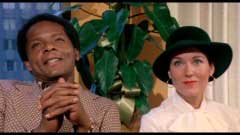 Vinegar
Syndrome’s 2-disc set features progressive, anamorphic widescreen (1.85:1)
transfers of both cuts of the film. THE SEVENTH DWARF seems a tad more worn,
but the colors are virtually the same on both transfers. The variations in sharpness
and graininess in different shots and scenes is evident in both cuts, so it’s
the fault of the original photography – including the greenish tinge due
to the fluorescent lights in the office scenes – rather than preservation
(and the shots and scenes specific to the original cut are in similar condition).
The Dolby Digital 2.0 mono tracks have been cleaned but are not totally free
of hiss and occasional noise, but there are no digital audio artifacts associated
with overzealous noise reduction either).
Vinegar
Syndrome’s 2-disc set features progressive, anamorphic widescreen (1.85:1)
transfers of both cuts of the film. THE SEVENTH DWARF seems a tad more worn,
but the colors are virtually the same on both transfers. The variations in sharpness
and graininess in different shots and scenes is evident in both cuts, so it’s
the fault of the original photography – including the greenish tinge due
to the fluorescent lights in the office scenes – rather than preservation
(and the shots and scenes specific to the original cut are in similar condition).
The Dolby Digital 2.0 mono tracks have been cleaned but are not totally free
of hiss and occasional noise, but there are no digital audio artifacts associated
with overzealous noise reduction either).

Director David Gottlieb does an audio commentary on the GAME SHOW MODELS version – a good choice since he was involved in the recut/reshoot – via telephone, so moderator Joe Rubin has to describe scenes to him as he prompts him with questions. It’s just as well that the commentary track largely abandons the scene-specific approach for stretches of the track which includes autobiographical background (he started out as pre-med at UC Berkeley but graduated with a theater degree before attending USC for film), his dealings with Sam Sherman, and the reshoot. He identifies actress Thomas as the same Diane Thomas who wrote ROMANCING THE STONE. Thomas died in a car accident in 1985 and is better remembered for the UCLA Diane Thomas Screenwriting Award in her memory (but she had been working on ALWAYS and a sequel to RAIDERS OF THE LOST ARK when she died), and is still touched by her work here. He also identifies some of the other one-off actors as stage performers and also reveals that Sommerfield followed up her on-screen career as a producer of PBS documentaries. He was able to get Los Angeles Times entertainment editor/critic Charles Champlin involved in the film through his association with Bernstein (and musician Willie Bobo – as part of Dana's entourage and also provides some of the film's additional music – through the film's composer Christopher Robin Culver). Rudin coaxes Gottlieb into talking about his experiences doing a documentary on Jim Jones and the Peoples Temple (and his feelings on what eventually happened). Of the reshoot, he discusses having to cast attractive women who didn’t mind taking off their clothes, and mentions getting the help of a couple involved in softcore filmmaking (although he doesn’t remember who they were). He also mentions that the original cast members were surprisingly not reticent about doing the sex scenes for the reshoot.
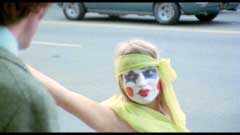 Unfortunately,
the set does not feature any additional commentary or video interview with Independent-International’s
Sam Sherman who might have provided some entertaining background on the film
(as he has on other discs with films he was directly involved in as well as
those he reworked for distribution). The outtakes (7:56) features some additional
game show footage, some frames from the opening sex scene, but mainly some surprisingly
explicit (although not hardcore) additional angles to the Stuart/CiCi scene
that suggest Gottlieb went all out with choreography of sequence not knowing
quite how explicit Sherman wanted it and how it would eventually be edited.
A stills gallery is also included. (Eric
Cotenas)
Unfortunately,
the set does not feature any additional commentary or video interview with Independent-International’s
Sam Sherman who might have provided some entertaining background on the film
(as he has on other discs with films he was directly involved in as well as
those he reworked for distribution). The outtakes (7:56) features some additional
game show footage, some frames from the opening sex scene, but mainly some surprisingly
explicit (although not hardcore) additional angles to the Stuart/CiCi scene
that suggest Gottlieb went all out with choreography of sequence not knowing
quite how explicit Sherman wanted it and how it would eventually be edited.
A stills gallery is also included. (Eric
Cotenas)